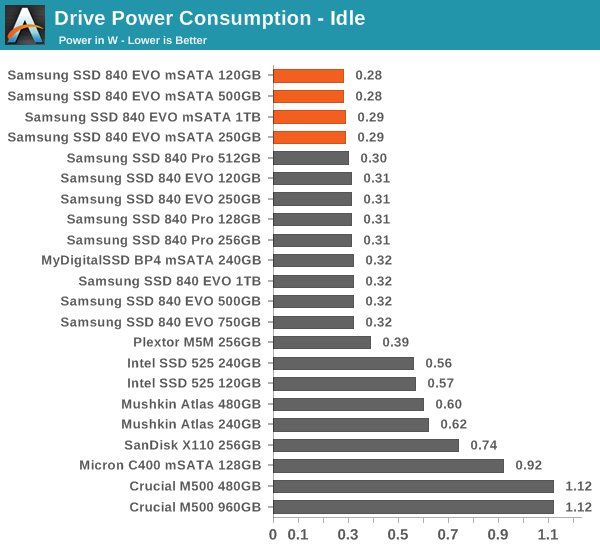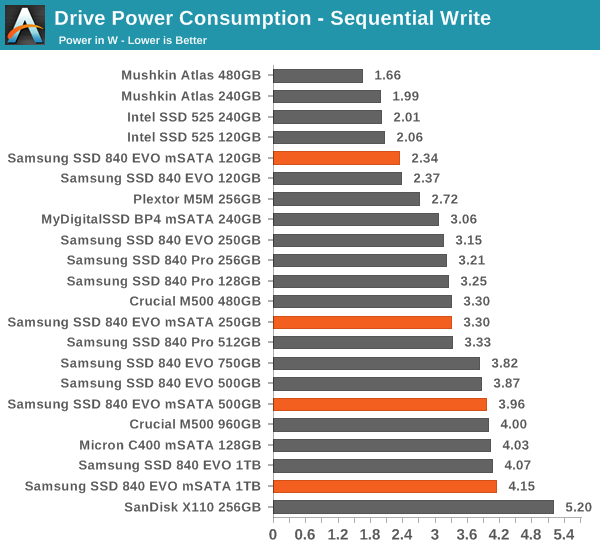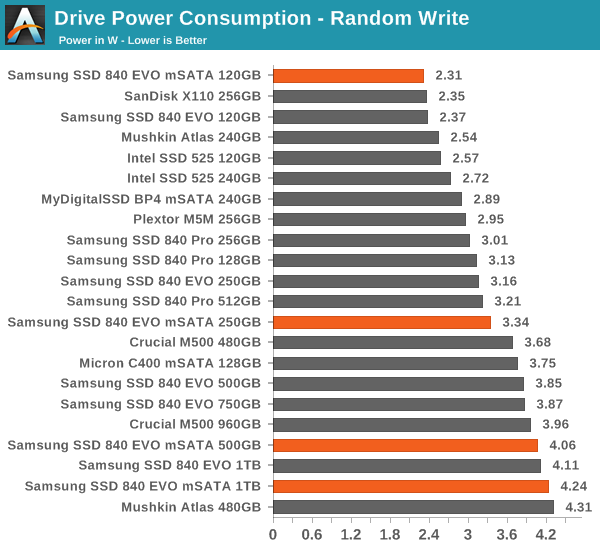Samsung SSD 840 EVO mSATA (120GB, 250GB, 500GB & 1TB) Review
by Kristian Vättö on January 9, 2014 1:35 PM ESTPower Consumption
One problem we have with testing mSATA SSDs is the fact that they require an mSATA to 2.5" adapter with a voltage regulator since 2.5" SATA is 5V whereas mSATA spec is rated at 3.3V. If you were to connect an mSATA SSD to a native mSATA slot, the power supply would automatically provide the drive with a voltage of 3.3V (SATA spec has three voltage rails: 3.3V, 5V and 12V) but because we have to deal with an adapter, the current we're measuring is based on the 5V rail (which the voltage regulator then changes to 3.3V). The voltage itself isn't the issue because it's fairly safe to assume that the adapter provides 3.3V to the drive but figuring out the difference between the input and output currents of the voltage regulator is. With the help of one of our readers (thanks Evan!), we were able to find out that the delta between input and output currents is typically 8mA (i.e. 0.008A) in the voltage regulator used in our adapter. Our measurements confirmed that as the adapter drew 8mA without a drive connected to it, although under load the regulator may draw a little more than that (datasheet claims a maximum of 20mA).
As we now know the difference between the input and output currents (current on 5V rail minus 8mA) as well as the voltage of the drive (3.3V), we're able to measure the actual power consumed by the drive. I've updated all mSATA SSD results to correspond with the change, so the number's you're seeing here are different from the ones you've seen in earlier reviews.
The EVO mSATA has great power characteristics, just like it's 2.5" sibling. There's no significant difference between the two and overall the EVO mSATA is one of the most power efficient mSATA drives. Unfortunately I don't have the necessary equipment to test slumber power consumption (HIPM+DIPM enabled) but I'd expect the EVO mSATA to have numbers similar to the 2.5" EVO (see the chart here).
The numbers here are worst-case scenarios and something I noticed during testing was that it takes a while for EVO to reach its maximum power draw. With the 500GB and 1TB models, the power draw was ranging between 2.2W and 2.5W for up to 30 seconds or so until it jumped to over 4W. I'm guessing this is due to TurboWrite because there is less NAND in use when the SLC buffer is employed (you simply don't need as many die to achieve high performance since program/erase times are much shorter). Once the buffer is full, the drive has to start writing to the TLC portion of the NAND, which increases the power draw as more NAND is in use. The downside is once you stop writing, the drive will keep drawing high power for a while in order to move the data from the SLC buffer to the TLC NAND. For example the 1TB model kept drawing ~3.5W for about a minute after I had stopped writing to the drive. I like Samsung's method because the garbage collection is done immediately instead of waiting for long idle periods like some manufacturers do -- doing garbage collection actively recovers performance quicker whereas it may take hours for idle garbage collection to kick in.













65 Comments
View All Comments
GreenThumb - Monday, February 10, 2014 - link
How would I know if a new laptop w/ Haswell processor could accept one of these drives?mdevlin - Friday, February 14, 2014 - link
One important point that was not captured in the review is thermal limiting. Our experience is that when doing large transfers (200GB+) the 1TB msata 840EVO starts to slow down and will sometimes run at 100MB/s or slower whereas we have not had this problem with the 2.5" 1TB 840 EVO. Doing a better job of cooling (even just fanning the air above a drive under test) improves mSATA performance. Not a big deal if you do not do large contiguous writes. We have never had any problem with Read performance.tomb18 - Monday, March 10, 2014 - link
Has anyone actually bought one of these 1TB drives?I have bought 2, from two different locations about 6 weeks apart. If you copy a large quantity of data (over 400gB) from another disk to one of these drives, they will fail during the write. They disappear completely, are not visible at all unless you do a reboot. Thje 500GB works fine.
I have verified this now on two different SATA3 controllers and on three different Windows 7 computers. Both 1TB drives fail on write.
RMA is in process with Samsung. I was told it sounds like a controller issue on the SSD.
mdevlin - Friday, March 14, 2014 - link
We have 6 of the 1TB mSATA drives and have no problem with large writes (up to 800GB) except the thermal issues mentioned above. With forced air cooling the performance is sustained throughout the transfer. without cooling speeds drop to less that 100MB/sec and it will actually pause and then resume (but not fail). we have had no failures after many full disk writes.mdevlin - Tuesday, April 8, 2014 - link
It seems that Samsung has updated the firmware on the 1TB mSATA 840EVO. Now when the mSATA drive overheats it throttles by alternately halting for a second, then running full bore for a second. This is less disconcerting than the previous version which would slow down for long periods or even stop for 10-20 seconds.